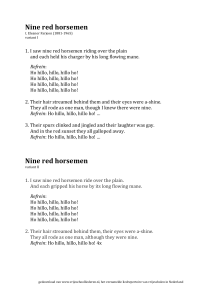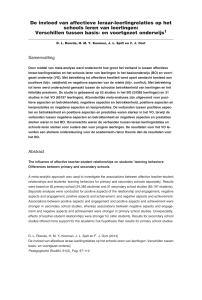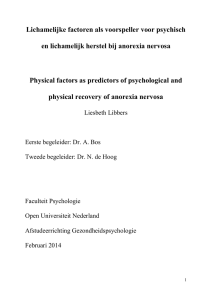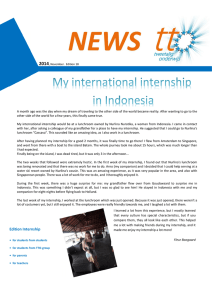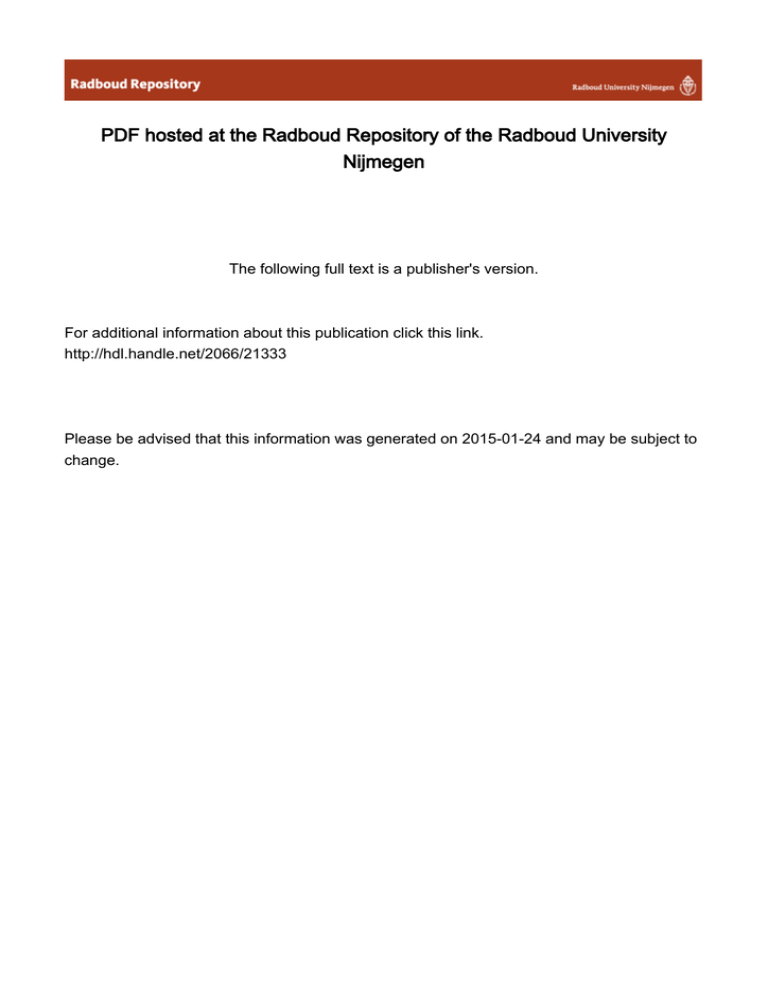
PDF hosted at the Radboud Repository of the Radboud University
Nijmegen
The following full text is a publisher's version.
For additional information about this publication click this link.
http://hdl.handle.net/2066/21333
Please be advised that this information was generated on 2015-01-24 and may be subject to
change.
ATHEROSCLEROSIS
¡£ .
ELSEVIER
Atherosclerosis 112 (1995) 237-243
Atypical xanthomatosis in apolipoprotein E-deficient
mice after cholesterol feeding
Janine H. van Reea,b Marion J.J. Gijbels3, Walther J.A.A. van den Broek0,
Marten H. Hofker , Louis M. Havekes*a
&TNO Prevention and Health, Gaubius Laboratory, P.O. Box 430, 2300 AK Leiden, The Netherlands
bMGC-Department o f Human Genetics, Leiden University, Leiden, The Netherlands
0Department o f Cell Biology and Histology, Nijmegen University, Nijmegen, The Netherlands
Received 1 July 1994; accepted 22 August 1994
Abstract
Apolipoprotein (apo) E-deficient mice were fed a hypercholesterolemic diet for 14 weeks. Mean serum cholesterol
levels rose to 37.5 mM. Upon complete necroscopy, massive xanthomatous lesions were noticed in various tissues, with
a predilection for subcutaneous and peritendinous tissues, while control animals on the same diet (3.4 mM serum cho­
lesterol) and apo E-deficient mice on a regular chow diet (20 mM serum cholesterol) did not show such lesions. Also,
apo E3-Leiden transgenic mice fed a high fat diet, with 60 mM of serum cholesterol, did not exhibit any xanthomatosis.
The xanthomatous lesions found in the Apoe knock-out mouse clearly differed in location from xanthomas previously
found in low density lipoprotein receptor-deficient mice. We conclude that the lack of apo E results in atypical dis­
seminated xanthomatosis, suggesting that apo E has an important role in determining the tissue distribution of choles­
terol deposition.
Keywords: Lipoprotein metabolism; Cholesterol deposition; Familial dysbetalipoproteinemia; Hypercholesterolemia;
Mouse model; Gene targeting
1. Introduction
Familial dysbetalipoproteinemia (FD), or type
III hyperlipoproteinemia, is a genetic disorder of
lipoprotein metabolism predisposing to premature
atherosclerosis. FD is defined by high levels of
plasma cholesterol and triglyceride, due to the acCorresponding author. Tel.: +31 71 18 14 49; F ax:+ 31
04
chylomicron and very
lipoprotein (VLDL) remnants [1]. The primary
metabolic defect of FD is mostly the presence of
mutant forms of apolipoprotein (apo) E, resulting
in a disturbed receptor-mediated clearance of lipo­
protein remnants by the liver [2]. In addition, FD
may also occur as a consequence of a complete
lack of apo E [3-6].
Recently, two types of mouse models for FD
have been generated [7-11]. One model comprises
0021 -9150/95/S09.50 © 1995 Elsevier Science Ireland Ltd. All rights reserved
SSD I 0021-9150(94)05419-J
238
J.H. van Ree et al. / Atherosclerosis 112 (1995) 237—243
conventional transgenic mice, overexpressing a
mutant form of human apo E, which in man causes
a dominantly inherited form of the disease [7 ,8].
Both the apo E3-Leiden and the apo E (Cys
112—Arg; Arg 142—Cys) transgenic mice display
increased levels of cholesterol and triglyceride in
the serum VLDL and low density lipoprotein
(LDL) fractions. The other model for FD
represents knock-out mice with a true null muta­
tion in the endogenous mouse Apoe gene [9-11].
These apo E-deficient mice show a much more se­
vere phenotype than the transgenics, with high
plasma cholesterol levels, even when fed a chow
diet. Diet-induced hypercholesterolemia and ath­
erosclerosis have been described for both FD
models [12-14].
The occurrence of xanthomas, an accumulation
of fat-laden histiocytes in various tissues, forms a
major clinical feature of hyperlipoproteinemia in
general. More specifically, about 50% of patients
with FD display tuberous xanthomas on the
elbows and/or yellowish lipid deposits in the
creases of the palms of the hands, the so-called
xanthomata striata palmaris. Both kinds of xan­
thomas are pathognomonic for FD [15]. In addi­
tion, tendinous lesions are sometimes observed in
FD patients.
Familial hypercholesterolemia (FH), which is
characterized by an elevated plasma LDL-cholesterol level, due to a defective LDL receptor
(LDLR), is often accompanied by typical ten­
dinous xanthomas in the achilles tendon and in the
extender tendons of the hands. Recently, Ishibashi
et al. showed similar grossly observable xanthoma
formation in cholesterol-fed LDLR-negative mice,
demonstrating that mice are also able to develop
xanthomas [16]. In contrast, the appearance of
xanthomas has not been described so far in mice
lacking apo E.
Here we report that, on histologic examination,
apo E-deficient mice fed a hypercholesterolemic diet
for 14 weeks do develop massive xanthomatosis in
all kinds of tissues, with a predilection for subcu­
taneous and peritendinous tissue. On the
macroscopic level, xanthomas could only be
observed after a much longer (6.5 months) dietary
treatment. We hypothesize that the lack of apo E
results in early atypical cholesterol deposition, sug­
gesting that apo E serves an important role in deter­
mining the tissue distribution of xanthomatosis.
2. Methods
2.1. Mice
Apo E-deficient mice were created by
homologous recombination in embryonic stem cells
as described [9] and were hybrids between the
C57BL/6 and 129 Sv strains. C57BL/6 mice were
used as controls. Apo E3-Leiden transgenic mice
from the high expressor line #181 had previously
been generated [7]. Experiments were performed
with males only. Mice were bred and housed under
standard conditions in the transgenic animal
facilities of the Medical Faculty in Nijmegen (Apoe
knockouts) and Leiden (controls and apo E3-Leiden
transgenic mice).
2.2. Diet
Mice were allowed access to food and water ad
libitum. The following diets were used, (a) A regu­
lar breeding chow diet (RMH-B) containing 6.2%
fat. (b) A mild high fat/cholesterol (HFC) diet con­
taining 15%cocoa butter, 0.25% cholesterol, 40.5%
sucrose, 10%cornstarch, 1%corn oil, and 6%cellu­
lose. (c) A severe high fat/cholesterol diet
(HFCO.5%) containing 15% cocoa butter, 1%cho­
lesterol, 0.5% cholate, 40.5% sucrose, 10% cor­
nstarch, 1% corn oil, and 4.7% cellulose (all
percentages are by weight). The semi-synthetic diets
HFC and HFCO.5% were composed essentially ac­
cording to [17]. All diets were purchased from Hope
Farms, Woerden, The Netherlands.
2.3. Histological analysis
Mice were sacrificed at 6-7 months of age, after
14 weeks of diet feeding. Complete necroscopy in­
cluding microscopic examination was performed.
Tissues were fixed in 10% neutral-buffered formal­
in, processed and embedded in paraffin. Threemicrometre sections were routinely stained with
hematoxylin-phloxine-saffron (HPS).
3. Results
Apo E-deficient mice and controls were fed a mild
hypercholesterolemic diet (HFC) for 14 weeks.
J.H. van Ree et al. /Atherosclerosis 112 (1995) 237-243
Thereafter, four null mutants and two controls were
sacrificed and a complete necroscopy was perform­
ed . Mean serum cholesterol levels were 37.5 mM
and 3.4 mM, respectively. Massive xanthomatosis
W a s observed in various tissues in all four apo Edeficient mice after cholesterol feeding as describ­
e d below, while no xanthomas could be observed
in controls on the same diet (Fig. 1).
Extensive xanthomatous lesions were observed in
the skin (compare Fig. 1A fpr controls with Fig. IB
for apo E-deficient mice; arrowheads indicate early
lesions) and subcutaneous tissues, extending into the
salivary glands (Fig. 1C). Lesions were also seen in
thyroid glands, muscles, periosteum and upper
mediastinum, including thymus (not shown). Fig.
1 D shows a higher magnification of a xanthomatous
lesion of the skin, with cholesterol clefts (ar­
rowheads), multinucleated giant cells (short arrow)
and necrosis (long arrow). Furthermore, xan­
thomatous lesions were found in periarticular and
peritendinous tissues (Fig. 1E, arrows) as well as in
the submucosa of esophagus and forestomach (see
Figs. IF and 1G for normal and mutant fore­
stomach, respectively; note the broadened submucosa in the null mutant). Remarkably, the lesions
abruptly stopped at the transition from squamous
epithelium to glandular epithelium (Fig. 1H).
Locations with mild xanthomatous lesions were
found in the mesothelium of the bladder and kid­
ney, and in the nasal mucosa (not shown). In the
brain, lesions were present at the origin of the choarrowhead)
of the
11, arrow) and
meninges
of lymph
many giant cells and
observed
Similarly, two age-matched apo E-deficient mice
on chow (serum cholesterol level of 20 mM) and
three high expressor apo E3-Leiden transgenic mice,
fed a severe hypercholesterolemic diet (HFC 0.5%)
for 14 weeks (serum cholesterol level of 60 mM)
[12], were studied. Neither microscopic nor
macroscopic analysis could reveal any xanthomas
in these animals.
So far, all xanthomatous lesions in apo Edeficient mice were observed after histological anal­
ysis. After 14 weeks on the HFC diet, there were
239
no signs of macroscopic xanthoma formation. To
investigate whether these mice could also develop
grossly visible xanthomas, a group of 30 homozy­
gous mutant mice and 30 wild-type littermates were
fed the HFC diet for a prolonged time. About one
third of the apo E-deficient mice had indeed
xanthomas
5 months
treatment
abnormalities
4. Discussion
This paper demonstrates that apo E-deficient
mice fed a hypercholesterolemic diet for 14 weeks
develop severe xanthomatosis. The xanthomatous
lesions were identified by histological analysis, and
showed a predilection for subcutaneous and periten­
dinous tissues, although more atypical locations
were also commonly observed. The process of xan­
thoma formation seemed to start at different
unrelated locations, such as the skin, especially near
the musculus carnosus, in the peritendinous and
periarticular tissues, in the submucosa of the
esophagus and forestomach, and in brain and men­
inges. Strikingly, at the transition from the fore­
stomach lined by squamous epithelium to the
glandular stomach, the lesions abruptly stopped (see
Fig. 1H): whether this intriguing finding might be
due to differences in cholesterol homeostasis in the
histiocytes in these two gastric mucosal locations
is subject to further investigation. Many other tis­
sues were affected, yet some major organs of the
reticuloendothelial system such as liver and spleen
displayed no abnormalities. Severe atherosclerotic
lesions were present in the aorta and in the pulmo­
nary and carotid arteries, as extensively reported by
others [13,14].
After 14 weeks of dietary treatment, only micro­
scopic, though extensive, xanthomatous lesions
could be observed in the apo E-deficient mice, with
no gross signs of xanthomatosis. Absence of gross
abnormalities in apoe null mutants, after being fed
a severe high fat diet for 3 months, was reported
earlier [16]. However, we found that after feeding
the mild HFC diet for 6.5 months, about one third
of the apo E-deficient mice had developed xan­
thomas on the face and/or on the distal part of the
J.H, van Ree et a l / Atherosclerosis 112 (1995) 237-243
240
• Xi
4
‘85 X ‘(0 snuiB|i?m puB (q) snduiBooddiq aqj uiaMjaq saSuiusui aqj ui uoiS9[ snojBUioqiUBX (f)
'9C X ‘(mojjb) ap u jim pjiqi a q i jo j o o j am ui (ÌJiBuiJÌpuadaqns puB (spBsqM oxiB) snxajd piojoqo a q j jo ui2uo sqj jb u o is s [ sno^Biuoqj
~UBX (I) ‘85 X ‘qrouiojs JBinpuBjS ui sjpo qons jo aoirasqs pus qoBiuojssjoj jo (s[po ju b i3 psjBajonupinui puB syap jo js js d jo q o qjiM)
«soomuqns puB (sjpa u ìb o j ¿(uieiu) moonui ut ssjXooijsiq U3pe[-pidji jo uopBjnumooB 3A[SU3}xa
-(s8) qoBtuojs JB(npuBjS oj (sj)
qoBuiojssJOj u io ìj uorjisuBJX (h ) '8SX ‘q^umojsajoj aqj jo Bsoonuiqns pouwpiqi XpiaAas aqj ut s8uBqo sno^BuioqjuBX (o ) '8SX
'uinrpqjido snourenbs ‘osaoui |ojjuo3 b jo qoeuiojsajoj (¡j) -9 £ x ‘(SM0JJB) ^ o q p sqj ui suoisq snojBuioqjuBx snouipuojusd pus
JBinopaBuad p iu g (3 ) 't t l X ‘sanssji isqjo ui suoisaj snojBUioquuBx joj aAriBjussajdai si qdBJgojoqd stqx
8uaj) stsoioau pus
(mojjb iioqs) sjpo jueiS ‘(spBsqMOJJB) sysp |QJ35S3|oqo qjiM. ui)js sqi jo uoissj saojBWoqjuBx b jo uoijbojjiuSbui jaq8|H (a) ' 8S X ‘(2s)
spUB[8/Cjbaijbs oqj ojui Siitpusjxs ui3|s aqj ui uoiss) snoiBUioqiuBx sjs/vag (3) ‘gs x X^0-1-16) shsoujbo sn(nasnui gqj jo sjubuuioj ajo^
•snsoujBO sninosnui sqj jbsu ftuiyBjs ‘utjjs am ui (spBsqMOJiB) uo;ss[ snojBiuoqjuBX X[JBg (g) ‘8
5x fsnsoaiBo sn|nosnui ‘dui iasnoui
[ojjuoo bjo urjfs (y) -30|ui juapyap-godBjo sanssp juaiaj/rp ui paAjasqo suoissj snojBUioqjUBXjo $qdBj8ojoqd aAiiBjuasaada^i •] -8ij
:;//, - . <
.
X
#
.^3 '
uSSifen
x:
.X\.
■ ■ > . . .
V .v -.
f. , '.' • '.
>/.\- ' ■> r1/'
'0', I
.
.
:.ìmk
j ■
*.cV.»•
il
:
:(■<
;
>' •'-S
'•*i«‘ >,•*1•>•*. ' •!
-i=-.' V:
>vi •-• ^
.•*.r'•À',**.*-'*
V ^ v V . .•.J:/::..}r<
1*>>•..**i Y:
Ì
ì'$* *..ì . \
C
V;/-, > *>*•:•*,*
,
..' .....
V 1*.'
'
:
v*.
V -- v' "
■.:
* ■* **',
/•'?<"
1n
SPZ^ùHZ (9 6 6 1 ) Z ì i sfsou9josoÀ9ifjy/ y » /a
uva
'ff'f
{*•
'
//o
w:
js is s b
[ B o iu q o g ; j o j U B u u a j j o
UI9IIÏAV 0 1 i m a j B j i 9JB q /&
S |U 3U 19äp3(M 0U 7(3y
• u o p i s o d a p i o j 9 j s a | o q o j o u o i}
- n q u i s t p a n s s p 9 q j 8 u t u n n i 9 j 9 p i n g p j } U B } io d u n
UB S9AJ9S a o d u }Bq} SUI99S j i ‘s p j o M J 9 q ; o U I ‘a o i m
jU 9 io ij3 p -g o d B g q i u i s u o is a f s n o iB iu o q iu B X g q j j o
SUOIVBOOJ p9JBUTUI9SSip J B I[ tl0 9 d g q i JO J 9 jq iS U O d S 9 J
9 q 0 ) SUU99S g o d B j o 3(ob[ 9 q i ‘s n q x • p 9 A J 9 s q o g q
p j n o o S B u io q ju B X o x d o o s o j o i u i j o o i d o o s o i o m u o u
}9 Á ‘] 9 t p 0 lU 9 8 0 J 9 q}B 9 J 9 A 9 S B S u t p 99 J U O d tl JAfUl 0 9
o i d n SJ9 A9 I j o J 9 iS 9 j o q o i n r u 9 S p a Ä B jd s ip g ö n n o tu g S
- s u b j i u g p i g q - ^ a o d B a q ; ‘9 jd iu B X 9 j o j - s i s o i B m o q i
-UBX
OldOOSOJOim
9AISU9JX9
d O [9 A 9 p
Ol
! U 9 p iJ
-jn s io u si 9U0(B [9A9J ¡ojgisgjoqo UIÎIJ9S qSiq B JBqi
g p n p u o o 9AV ‘9J0j9J9qx ■rasqoqB pui ui9}0Jd0dq pg
- q jn is ip B qiiM goiiu ino-^oou3( jo oiu 98 subji jg q jo
JOJ p9JJ0d9J U99q }0 U 9ABq SU0piS0d9p ptdl[ [BOldÄJB
j b ( i u i i s 'SB U ioqïU BX g jq isiA Æ [s s o j3 g q i S9p909id
S u o i StSOlBUIOqjUBX OldOOSOJOim 9AtSU9}X9 P91
-BUIUI9SSIP jgqiB J aq i ‘Xjjb9J3 -[9 1 ] 9orm ju g p tjg p -g
odB Jno
|qBJBdUIOO SpA { I J }S [ q BUI
“SBfd qilM ‘gu ip j [OJ S |OqO JO SqiUOUl J JB SISOl
-BUIOqjUBX DtdoOSOJOBUI u i [tJJS p M qS OS|B im
l u a p y g p - ^ n c n S9JÏ11B9J o iu o rao u S o q iB d ssgqi
9jqm 9S9J ÁJJB9P 10 U Op 901UI JU 9ptJ9p-g OdB 9qi
ui SBuioqiuB x DtdoOSOJOBUI gq;
spreuqBd bjbijis
BjBUioqiUBX puB SMoqp gqj u o SBUioqjUBX snoJ q m
iBOidXj iiq iq x 01 p g y o d g j U q ABq Xougioipp a
odB qitM sjU iiBd a a q S n o q ijy
-gig) q u itp io j
0
1
9
9
9
9
3
1
0
3
3
3
I
8
3
9
0
0
9
0
1
9
0
9
9
9
9
9
9
'
(
z
'ssnoui
jusioyap-godB ui qiuipjoj jo jJBd jBjsip jo u o is s j s n o jB u io q iu B X (Q ) 'ssnoui 3dX;-p|iM v jo quiipjoj (3) ‘asnoui ino-^ooujj jo aoej jo
uoiss| sn o iB u io q ju B X ( a ) 'asnoui sd^i-pjiAVjo sob j (y ) •qdBJ8ojoqd aqj jo auni sqj 38b j o sqjuoui ç'i aw/ft puB ‘sqjuoui 5 9 j o j jaip
DdH 3l0 p3j 3J3M so¡ui qjog
sd^j-pjiM v qjiM psJBduioo sb ssnoui juapyap-g odB u b ui sBuioqjuex ajqisu ^[ssojq 'Z
•m m
WSmmÊmmmrnM'
i É i Â
■
« « »
:i,
wmÈ^wiï: m
turn."Vêfâmïw
i f , 'Î S Â
■ iß iM m
■■■■■■
■■■■ ••
•
■r''-y
'
< \ Í
■
I **" •'/*• ' ’<' / 1***’
' y^ ''•y"*•
%
"*V‘
1• ' ' ' ' ‘ ' *' * ****':'•
.'• ' ’; V | ' ' '
^
i - > / •<-<,1, - j*.'•
• • > * f « '*.* •; i • •* / % • i •
• i ' - • -. ù
,. - - ' ,
*« ’ ,■ \ ’ V;
'X
•*
/ ' '
,f
•
l
's*. .* •i • ’
**Í :
*
>
j
“A k\a?)S
^
: V
• .rv
;
"A:
*'•*
' *• •*<*
^
:.
I ' ^ v -< ï •'/,i-’]::
•
\ ‘, •;V
•* •
, ' < • y
'■/•,.' . y
'
!\
'
•:
//i-il 0}^: ■.
■-y* ¡■,
'¿ s.’.t'
- / .
'fi,
-V;; ^^'/,*-,.^
'f/*
s, f '
' '
’ >
,
.
* *■
'*/ {
-j I*.'
1:
V*.
v,n;'
i%/ . %
s/'
• ?• • *
/ *
’ *•
'!
r V*'
;r •.•;lir- <-i‘ :i : - r?•l í ;• •' ! ' v:Ví V-.:.r•:; :;::V.:
*y''
^v*'*•y f 1 /****-•''!* *•^ ^*'*
’<Ì
£ P Z ~ ¿ £ Z ( S 6 6 1 ) Z ì i S ìs o u a p s o u d ijìy
/
70 ;a
a a y «m
H f
ZPZ
J.H. van Ree et at. / Atherosclerosis 112 (1995) 237-243
leagues of the Central Animal Laboratory of the
Medical Faculty, Nijmegen University for animal
care. Drs. Chris Zurcher and Maya Ponec are
thanked for helpful discussions. This research was
supported in part by the Medical Genetics Centre
South West Netherlands (MGC), the Netherlands
Heart Foundation (projects #900-504-092 and #91071) and the Dutch Royal Academy of Arts and
Sciences (to M.H.H.).
References
[1] Mahley, R.W. and Rail, S.C., Jr., Type III hyperlipopro­
teinemia (dysbetalipoproteinemia):
the
role
of
apolipoprotein E in normal and abnormal lipoprotein
metabolism. In: Scriver, C.R., Beaudet, A.L., Sly, W.S.
and Valle, D. (Eds.), The Metabolic Basis of Inherited
Disease, 6th Edn., McGraw-Hill, New York, 1989, pp.
1195-1213.
[2] Mahley, R.W., Innerarity, T.L., Rail, S.C., Jr.,
Weisgraber, K.H. and Taylor, J.M., Apolipoprotein E:
genetic variants provide insights into its structure and
function, Curr. Opin. Lipidol., 1 (1990) 87.
[3] Ghiselli, G., Schaefer, E.J., Gascon, P. and Brewer, H.B.,
Jr., Type III hyperlipoproteinemia associated with
apolipoprotein E deficiency, Science, 214 (1981) 1239.
[4] Mabuchi, H., Itoh, H., Takeda, M. et al., A young type
III hyperlipoproteinemic patient associated with
apolipoprotein E deficiency, Metabolism, 38 (1989) 115.
[5] Kurosaka, D., Teramoto, T., Matsushima, T. et al.,
Apolipoprotein E deficiency with a depressed mRNA of
normal size, Atherosclerosis, 88 (1991) 15.
[6] Lohse, P., Brewer, H.B., III, Meng, M.S., Skaralatos,
S.I., LaRosa, J.C. and Brewer, H.B., Jr., Familial
apolipoprotein E deficiency and type III hyperlipopro­
teinemia due to a premature stop codon in the
apolipoprotein E gene, J. Lipid Res., 33 (1992) 1584.
[71 van den Maagdenberg, A.M.J.M., Hofker, M.H.,
Krimpenfort, P.J.A., de Bruijn, I., van Vlijmen, B., van
243
der Boom, H., Havekes, L.M. and Frants, R.R., Trans­
genic mice carrying the apolipoprotein E*3-Leiden gene
exhibit hyperlipoproteinemia, J. Biol. Chem., 268 (1993)
10540.
[8] Fazio, S., Lee, Y.-L., Ji, Z.-S. and Rail, S.C., Jr., Type
III hyperlipoproteinemic phenotype in transgenic mice
expressing dysfunctional apolipoprotein E, J. Clin. In­
vest., 92 (1993) 1497.
[9] van Ree, J.H., van den Broek, W.J.A.A., Dahlmans,
V.E.H. et al., Diet-induced hypercholesterolemia and
atherosclerosis in heterozygous apolipoprotein Edeficient mice, Atherosclerosis, 111 (1994) 25.
[10] Zhang, S.H., Reddick, R.L., Piedrahita, J.A. and Maeda,
N., Spontaneous hypercholesterolemia and arterial le­
sions in mice lacking apolipoprotein E, Science, 258
(1992) 468.
[11] Plump, A.S., Smith, J.D., Hayek, T. et al., Severe hyper­
cholesterolemia and atherosclerosis in apolipoprotein Edeficient mice created by homologous recombination in
ES cells, Cell, 71 (1992) 343.
[12] van Vlijmen, B.J.M., van den Maagdenberg, A.M.J.M.,
Gijbels, M.J.J. et al., Diet-induced hyperlipoproteinemia
and atherosclerosis in apolipoprotein E3-Leiden trans­
genic mice, J. Clin. Invest., 93 (1994) 1403.
[13] Nakashima, Y., Plump, A.S., Raines, E.W., Breslow,
J.L. and Ross, R., ApoE-deficient mice develop lesions
of all phases of atherosclerosis throughout the arterial
tree, Arteriosclerosis Thromb., 14 (1994) 133.
[14] Reddick, R.L., Zhang, S.H. and Maeda, N., Athero­
sclerosis in mice lacking apoE. Evaluation of lesional de­
velopment and progression, Arteriosclerosis Thromb., 14
(1994) 141.
[15] Polano, M.K., Xanthoma types in relation to the type of
hyperlipoproteinemia, Nutr. Metabol., 15 (1973) 107.
[16] Ishibashi, S., Goldstein, J.L., Brown, M.S., Herz, J. and
Bums, D. K.., Massive xanthomatosis and atherosclerosis
in cholesterol-fed low density lipoprotein receptornegative mice, J. Clin. Invest., 93 (1994) 1885.
[17] Nishina, P.M., Verstuyft, J. and Paigen, B., Synthetic
low and high fat diets for the study of atherosclerosis in
the mouse, J. Lipid Res., 31 (1990) 859.

